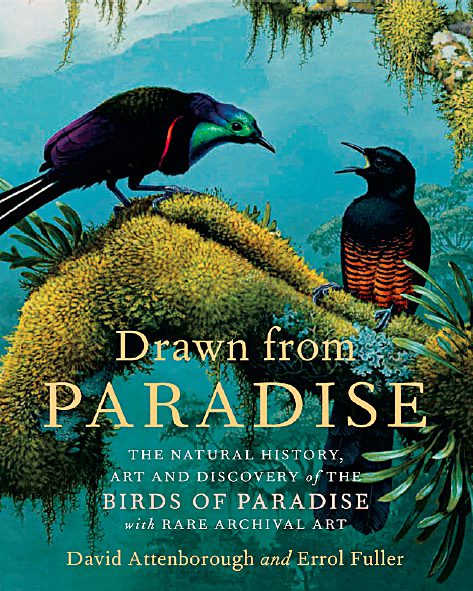Book Review: Drawn From Paradise, by David Attenborough and Errol Fuller
Review by Stephen J. Bodio
October 15, 2013
This book, cowritten by David Attenborough—the grand old man of nature films—and Errol Fuller—a one-time boxing painter and collector of Edwardian stuffed bird collections, who may be our best chronicler of extinct birds—is worthy of its neoVictorian subtitle: a grand account in art of our growing understanding of these implausible birds. It is also thoroughly modern, or even postmodern: pages 8 to 19 examine the details of the painting called End to the Squandering of Beauty (Entry of the Birds of Paradise into Western Thought). It is, like all Ching paintings, utterly brilliant and barking mad: a circle of birds including Golden Eagles, magpies, domestic pigeons, and a couple of flying birds-of-paradise surround a blanket borne aloft by two Great Blue Herons containing museum specimens of most of the birds-of-paradise, with a figure of the Eiffel Tower in the background.
But if you don’t like whimsy, you don’t like birds-of-paradise. The rest of the book documents their progression in Western consciousness from the first footless skins, of creatures imagined never to alight until they died, to the thoroughly modern William Cooper, and in paintings ranging from the work of master portraitists in the 17th century to today. All of the familiar (to those of us who love birds) 19th-century printmakers’ images that tried to imagine courtship dances are there, as is the 1950s National Geographic artwork by Walter Weber that gave my generation its first impressions. They are splendid and evoke nostalgia, but my favorites are at the beginning and end of the series: an anonymous painter from circa 1560, who evokes something celestial and footless but as utterly real and soft as an Impressionist flower; and the most modern—the surrealism of Ching and the biological correctitude of Cooper (which is not without humor). One more black-and-white sketch deserves notice, not because it is great art but because it depicts the tracks of a great man. Alfred Russel Wallace saw the dance of his eponymous standardwing, and described it to engraver T. W. Wood for his immortal Malay Archipelago in 1869. Darwin’s humble eternal mirror image and congener, Wallace was always the man on the spot.

All About Birds
is a free resource
Available for everyone,
funded by donors like you
American Kestrel by Blair Dudeck / Macaulay Library


